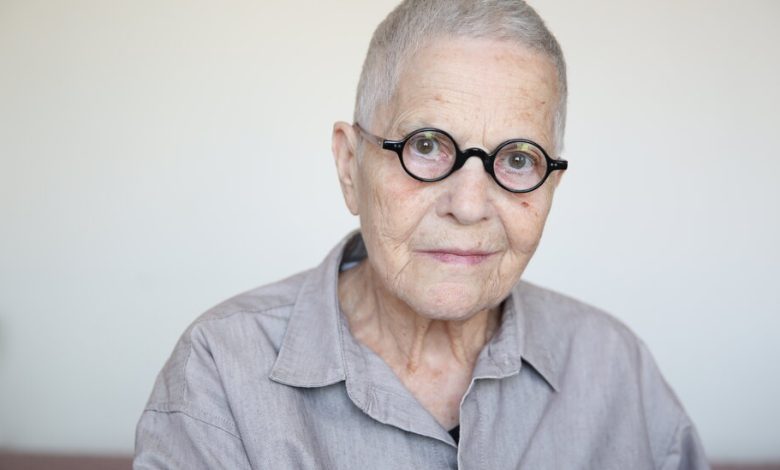Ida Applebroog, Whose Art Confronted Relationships, Dies at 93

Ida Applebroog, who confronted the violence, coercion and mortality that simmer beneath everyday relationships with a prolific stream of drawings, paintings, sculptures and videos, died on Oct. 21 at her home in Manhattan. She was 93.
Her death was confirmed by her art studio.
Ms. Applebroog’s sui generis practice first came to notice in the mid-1970s, when she started mailing self-published booklets of her art, with fragments of cryptic text, to artists and writers she admired. Though the booklets drew on her background in commercial art and have been compared to comic strips, they had a stranger tone and a deeper bite than the average cartoon.
Writing in The New York Times in 2010, Randy Kennedy called them “funny in a way that skews toward weird without losing the ha-ha.” But in their sometimes willful blankness, the way they quivered with allusions while skirting overt statements, they also demonstrated Ms. Applebroog’s comfort in grappling with the unspeakable, the unshakable and the unknown.
“I’m more interested in doing something to the viewer,” she said in “Call Her Applebroog,” a 2016 documentary directed by her daughter Beth B., “than saying something to the viewer.”
Over time Ms. Applebroog developed a varied but recognizable style in multiple mediums, characterized by the raw, mordant humor of a woman under no illusions. Calling herself an “image scavenger,” she sourced figures from popular media, continuing the drawing-board-like approach of her early booklets on a larger scale. She later turned to rougher edges and more shocking colors in expressionist paintings of women and men in naïve, ghostly outline, and more recently, her drawing hand compromised by arthritis, she focused on sculpting little birds with children’s clay.
Though she avoided direct polemic, her work was deeply involved with gender and authority; though she avoided personal revelation, it came straight from the heart. Even when she did make a political statement, she refused the easy comforts of certainty. And if her drawings could come across as violent or disturbing, it was only because she was working from life. In her 1983 photolithograph diptych “So?,” a woman saying “He says abortion is murder” is met by a group of men retorting, “Why else did God give us the bomb?”
“It’s hard to say ‘What is your work about,’” she said in a 2005 interview with the website Art21. “But for me it’s really how power works — male over female, parents over children, governments over people. Doctors over patients.”
Ida Applebroog was born Ida Applebaum on Nov. 11, 1929, in the Bronx. Her father, Isidore Applebaum, had moved from Poland six years earlier, but brought over his wife, Sara, and his older daughter, Frieda, only that year. A third daughter, Gloria, was born eight years later.
The household was not a happy one. Sara was depressed, Isidore was at times violent, and both adhered to a confining version of ultra-Orthodox Judaism. Despite this less than encouraging environment, Ms. Applebroog’s artistic impulses developed early.
“The first time I ever did know I was an artist is when I was about 5 years old,” she recalled. “I wanted my father to draw something for me, and what he drew for me was a stick figure. And I showed him what I can do, and at that moment I knew I was the artist and he wasn’t.”
What she had drawn was a princess wearing a crown.
She finished high school against her father’s wishes. He was a furrier and wanted her to work for him. She did that, too, for a while — but after she told her mother that some customers had groped her while she modeled fur coats, she was allowed to stop.
Ms. Applebroog enrolled in the New York State Institute of Applied Arts and Sciences in 1948 and then worked briefly at an advertising agency. The sexual harassment there was even worse than it had been in her father’s shop, so she moved on to a job in the picture collection of the New York Public Library. Eager to broaden her education in both commercial and liberal arts, she took night classes at City College.
She married Gideon Horowitz in 1950. They had four children and, in 1956, moved to Chicago, where he was pursuing a doctorate at the University of Chicago’s School of Social Service Administration. Once her youngest was in kindergarten, Ms. Applebroog began studying at the School of the Art Institute of Chicago, where she was deeply struck by the work of Claes Oldenburg. She also made jewelry, which her husband and children sold at art fairs.
In 1968, the family moved to San Diego, where Mr. Horowitz had been offered an academic position. Ms. Applebroog rented her first art studio, a 15-minute drive from home in a former Chinese market. She met the artists Judy Chicago, Miriam Schapiro and Kathy Acker and began to show her work. But sunny Southern California didn’t agree with her, and in 1969 she checked herself into Mercy Hospital San Diego with severe depression.
There she compulsively made drawings — dreamy, unnerving, semi-figurative ones. During a visit home, she had another creative breakthrough.
“I had four children,” she explained in a 2010 interview with NPR. “Anyone who’s ever been a mother knows that the place of sanctuary, of just having some very quiet time, is to go into the bathroom, say you’re taking a bath. I do drawing all the time. It’s like instant coffee. I just love drawing and it just comes out all the time. So I sat on the bathroom floor in front of a full-length mirror and I just did these drawings of my vagina.”
When she rediscovered these drawings, about 40 years later, she found that she had made 163 of them.
In 1974, Ms. Applebroog moved back to New York, settling first on Crosby Street in SoHo and later moving a block over, to Broadway. (Her family eventually followed.) She had been making biomorphic sculptures with muslin fabric and cellophane, but she was told that they looked too much like the work of the sculptor Eva Hesse, so she threw them away.
Instead she began making books — diarylike compilations of passages she had read, images that struck her or phrases that ran through her head, as well as the pamphlets she sent out from the Canal Street post office in Lower Manhattan. Soon people were asking to be added to her mailing list; it ultimately reached around 500.
Ms. Applebroog also fell in with a loose group of feminist artists and curators, including Ms. Schapiro, Lucy Lippard, Pat Steir and others, who were putting out a journal called Heresies. The artist Martha Rosler filmed her 1975 video “Semiotics of the Kitchen” in Ms. Applebroog’s Crosby Street kitchen.
Still, she would later chafe at the label “feminist artist,” as she chafed at every label. “I don’t consider myself a sculptor, or a painter, or a book artist or a conceptual artist,” she said in the Art21 interview. “I just make art.”
She began to chafe at her name, too. Her earliest work is still signed Ida Horowitz, but in 1975 she decided she no longer wanted to use any man’s name — not her husband’s, not her father’s — and she coined and adopted Applebroog.
Ms. Applebroog is survived by her children, Beth B., Paul Horowitz, Ned Horowitz and Debra Dodd; seven grandchildren; and her sister, Gloria Bornstein. Her husband died in 2015.
In 1978, a number of her films were screened at the Whitney Museum, and in 1980, Ms. Lippard asked her to make an installation for the windows of the nonprofit art space Printed Matter in TriBeCa. The diptych she made of an elderly man preparing for bed inaugurated a new, larger scale for her work. In 1981, when the gallerist Ronald Feldman moved his operation to SoHo, he gave her the first show. She would continue to show with him for nearly 30 years.
(Mr. Feldman liked playing practical jokes, like calling Ms. Applebroog to tell her she’d won the Publishers Clearing House sweepstakes. In 1998, when she received a phone call from the MacArthur Foundation telling her she’d won a so-called genius grant, Ms. Applebroog’s first response was “Tell Ron that isn’t funny.”)
In 2009, she joined the Hauser & Wirth gallery. In 2012, she was included in the Documenta 13 festival in Kassel, Germany, and in 2021, the Reina Sofía museum in Madrid held a retrospective. Her work is in the collections of the Metropolitan Museum of Art, the Whitney Museum, the Museum of Modern Art and the Guggenheim Museum.



